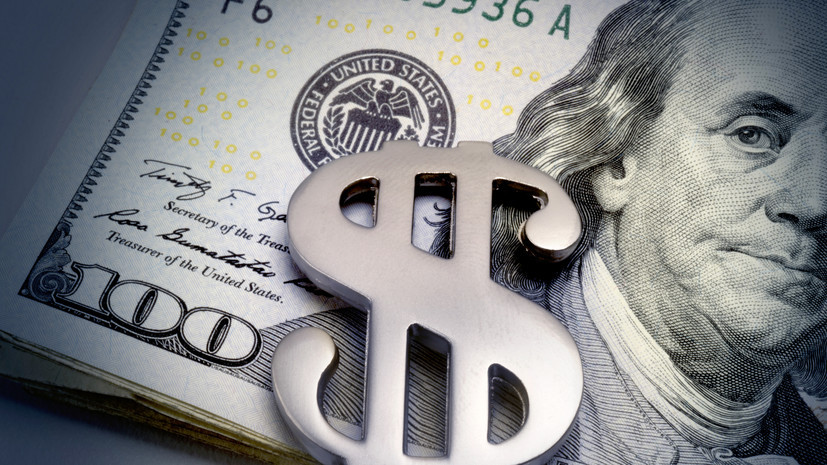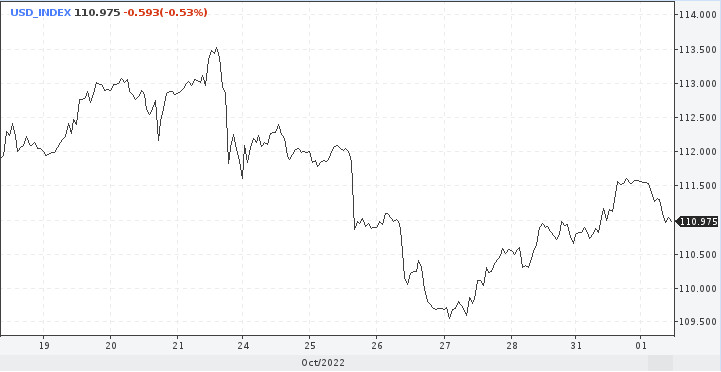

The dollar has rolled back recently, but it can hardly be called a change in trend in the face of tightening monetary policy in the United States. The rate hike cycle has not reached its peak, and market players are trying to run ahead of the locomotive, putting the Federal Reserve's easing rhetoric into quotes.
It's too early to discount a strong US currency, and under the current conditions it's hard to imagine what could be the reason for its weakness.
Nevertheless, the weakness was fixed, last Thursday the dollar index touched a monthly low. The fact that tightening is starting to take its toll on the business cycle is fueling expectations for monetary easing soon.
It is currently the period of reporting companies for the third quarter in the US. Companies such as Meta, Microsoft, Amazon and Alphabet have reported disappointing results.
Microsoft posted the lowest sales growth in five years, and its fiscal second-quarter revenue guidance came in below Wall Street's estimates. Alphabet reported low ad sales and warned of a slowdown in spending growth.
Looking at Microsoft's corporate numbers, one can draw certain conclusions: corporate IT budgets are under pressure. Meanwhile, Alphabet's declining ratings suggest that consumers have exhausted their options. Both of these factors are a kind of signal for a slowdown in the US economic recovery.
"At the moment it is difficult to understand what is causing the weakening of the dollar. The Fed has not yet reached the rate limit, the US economy looks a little more resilient than the economies of some other countries," writes JPMorgan.
Now traders are hiding and considering the dollar's succeeding direction, which will largely depend on the events of the current week, primarily on the Fed meeting on Wednesday.
Speculative easing monetary policy is fueling the actions of other central banks. The Bank of Canada, for example, raised rates less than expected.
The strong dollar forced Japanese politicians to defend their currency, although this had limited results. In general, the dollar received some pressure from this side too.
However, it will take time to be sure that the dollar will reach a peak and start a trend reversal. Markets need to make sure, get confirmation.

While the dollar bulls remain on horseback. The hawkish stance of the Fed, fears of a global recession and escalating geopolitical tensions in Europe should support demand for the US currency.
Ahead of the FOMC meeting, the fundamental background remains positive for the dollar.
As for the pace of rate hikes, the opinions of members of the US central bank and economists are divided. Philadelphia Fed Chief Patrick Harker said officials are likely to raise rates "well above" 4% this year. According to his Chicago colleague, exceeding this level can be costly, and "there is a lot of uncertainty about how restrictive policy should actually become."
Goldman Sachs Group believes that the Fed may raise rates to 5% by March 2023, which is 25 basis points higher than previous forecasts.
Goldman Sachs Chief Executive David Solomon said last week that the central bank would push rates above 4.5% to 4.75% if it didn't see a real change in inflationary behavior.
Banking analysts say the 5% upside path includes a 75 bps hike on Wednesday, 50 bps in December and 25 bps in February and March.
Thus, the next meeting should shed light on how long the Fed will maintain an aggressive monetary policy. Until traders have a clear idea of how much the US central bank intends to raise rates, there will be no turning point for the dollar.
At the beginning of the week, the dollar index was able to recover to fresh highs for the last four sessions around 111.30, but the pressure on it remains. Strong support now appears to be at 109.50.
The upward trend in the near term will continue as long as the indicator is trading above the 8-month support line around 108.50, analysts say. Bulls will aim for an upward bounce in the area of monthly highs around 114.00.
If the Fed does not change its position, the dollar will remain strong, economists at MUFG Bank write. Otherwise, the US dollar index will rush down.
The undesirable fate of the euroAs for EUR/USD, the chances of recovering positions above parity seem slim. The key event here is also the Fed meeting. No matter how the US central bank does, the European Central Bank will find it difficult to keep up with it, or rather impossible.
The ECB raised rates by 75 basis points last week, and a further move is likely in December after core inflation accelerated to a new record. However, a 50 bps hike would be more preferable if incoming data starts to signal a significant slowdown in the economy in the fourth quarter.
Analysts warn that the eurozone will not be able to resist a slide towards negative growth for long.
"The contraction of the eurozone has not yet begun, as GDP growth for the third quarter was 0.2%. However, inflation continues to rise, preparing the eurozone economy for a harsh winter as a recession looms," commented ING.
Although inflation has reached a new record and the economy continues to grow, ING economists expect the ECB to slow down its rate hikes.
The tone of the October announcement was less hawkish, suggesting that one should not hope for a massive rate hike similar to last week's (75 bps).
"The picture remains grim. Consumer confidence is near historic lows as real wage growth is now at its lowest level in decades. This has a significant impact on the consumption outlook, as retail sales have already been declining in recent quarters," ING economists said.
Meanwhile, on Tuesday the EUR/USD pair managed to recover its positions and rose above 0.9900 mainly due to renewed pressure on the dollar. The technical picture suggests a bullish bias. In order to extend it, the euro needs to be above 0.9920 and start using this level as support. In this case, additional growth to 0.9960 and 1.0000 will be possible, but it is unlikely to last long.
Support is found at 0.9900, followed by 0.9880 and 0.9830.